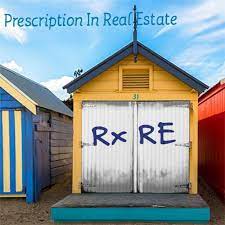Real Estate Prescription Review
Danielle Mapes is the mastermind behind this real estate program, which promises to help realtors build a deal-a-day pipeline without buying leads, doing open houses, calling FSBOs and expired listings, or door-knocking. Real Estate Prescription Review claims that in just 66 days, realtors can be on the verge of a fortune while working 1-2 hours less per day.
An easement is a non-possessory right to use another party’s property (learn more about Equitable Easements here). While they can be created by express grant or court order, they may also be acquired through a process known as “prescription.” Prescription is similar to adverse possession but allows for an easement to be established over time instead of by active ownership.

For a person to establish a prescription easement, they must have been using the land in question openly, continuously and without the owner’s permission for a specified period of time. In addition, the usage must have been hostile, which means that it was against the owner’s rights and that they did not take action to stop the usage.
Let’s say that your neighbor uses a portion of your land as a shortcut every day when they leave their home. If this continues for long enough, they might be able to gain a legal right to continue this practice through a prescriptive easement.
However, it is important to note that the usage must be both open and notorious in order for a prescriptive easement to be granted. If a party only crosses your land quietly, or at night when the owner cannot notably witness them, then it is unlikely that a prescriptive easement will be granted.
It is also essential to remember that a prescription easement must be exclusive in order to become effective. If a landowner allows multiple parties to utilize their property in this manner, then the claimant cannot establish a prescriptive easement. In addition, a prescriptive easement can be terminated if the landowner takes active action to prevent its use, such as by putting up a fence.
Creating an easement through prescriptive possession depends on state law. However, there are some basic requirements in most jurisdictions. The usage of the land or property must be actual; open and notorious; and continuously for a specified time (the length of which differs by state). It also must be adverse to the rights of the owner.
A common example is a neighbor’s driveway, which is used by you and your family to get to your home, even though the homeowner has never given permission for this use. If you erect gates or blockades to stop your neighbors from using the driveway, this will be considered an adverse use and could result in the creation of a prescriptive easement.
You can avoid a prescriptive easement by seeking permission for outside parties to access your property. This can be done by requesting a written license to use the area or asking for a fee. Alternatively, you can ask for extra home insurance liability coverage to protect yourself in case an accident or injury occurs on your property and someone claims they have a prescriptive easement over it.
When buying a home, an existing prescriptive easement usually turns up in a title search or abstract of title, and can be linked to the property (or “runs with the land”), regardless of who owns it. It’s usually not a deal breaker for homebuyers to find out that a prescriptive easement exists, and in some cases, it may actually be beneficial. For instance, you may be able to negotiate a price adjustment for your purchase, if you decide the easement negatively affects the value of your property. However, you should consult with a real estate attorney to make sure you understand the impact of the easement and any possible alternatives.
A prescriptive easement’s duration is limited to a specified time period under state law. This limitation is to prevent the claimant from gaining an unintended, perpetual right to use property that may not be legally his or hers. It also limits the scope of the claimant’s usage to a narrowly defined path through the landowner’s property. The holder of the easement cannot change or expand this usage, so it must remain the same during the prescription period.
This limitation to the scope of the easement can sometimes be problematic. For example, let’s say a person used a portion of his or her neighbor’s property to travel from one point to another on a regular basis, and did so for 10 years. The neighbor never told the trespasser to stop, so the travel became a regular part of this person’s daily routine. This demonstrates the open and notorious element of an easement, but it does not necessarily meet the adverse, hostile, or adverse-to-the-owner’s-rights requirement for a prescriptive easement.
Moreover, the trespasser cannot change or expand his or her usage during the prescription period. For example, a person who uses his or her neighbor’s land to drive to work every day must continue doing so until the property is sold. Then, the new owner can either continue this use or discontinue it.
If you are thinking of buying a property with a prescriptive easement, conducting a thorough title search and seeking legal advice is always a good idea. This can help to ensure that you will have a clean, free-and-clear title when you buy the property and avoid any future legal problems related to the easement.
A prescriptive easement differs from an ordinary easement granted by deed because it’s a right that you create through open and notorious use without the permission of the landowner over an extended period. The right must be continuous and uninterrupted, but it also has to be “adverse.” This means that the user has to act in a manner that would be considered a trespass if you were the owner of the property.
This type of easement most often arises when neighbors use each other’s driveways or side yards to access their own homes, such as in an apartment building where residents regularly walk across the neighboring homeowner’s pavement or grass to get to their own apartments. This usage could eventually become a permanent easement under prescriptive law, but the property owner must take some action to show that they are claiming the right.
Prescriptive easements can be beneficial for property owners because they allow them to preserve the value of their real estate. However, they can be problematic for homebuyers who may not want outside parties using their property without their knowledge or consent. It’s important to speak with a real estate attorney before buying a property that has an existing prescriptive easement, especially if the easement has been used for a long time.
It’s also a good idea to consider extra homeowners insurance coverage, as you could be held liable for accidents or injuries that occur on the property. Despite the potential downsides, having a property with an existing prescriptive easement shouldn’t necessarily be a deal-breaker for most prospective homebuyers. But, you should be sure to thoroughly examine the situation before making a final decision.
If someone starts using your property without permission and keeps doing it over time, they may be able to claim an easement by prescription. This could prevent you from putting up a fence, or even stop you from using your own property for certain purposes. For example, if a neighbor uses your land to walk a trail behind the house, you would likely not want them to get an easement by prescription, because it may prevent you from putting up a fence that might be necessary for your safety and that of others.
While the law of prescriptive easements can be confusing and differs by state, most states recognize that an easement by prescription grants a legal right to use another person’s land, but only for a specific purpose. This is different from the legal concept of adverse possession, which allows a person to claim full ownership rights including the right to build. Unlike adverse possession, a prescriptive easement does not require a quitclaim deed or fee simple title and can be shared among several parties.
For example, let’s say that a party has used the back of a property for years to take a shortcut to school. The party never asked the owner for permission, but it seems as though they’ve been doing it for as long as anyone can remember. This usage could qualify as an easement by prescription, because it meets the open and notorious requirement.
It’s important to understand the concept of prescriptive easements before you purchase a home. This is especially true if you are planning on erecting fences or other structures to block off access to your property, or if you plan on changing the way you use your land. It’s also a good idea to have extra home insurance liability coverage in case someone gets hurt on your property, despite an existing easement.




